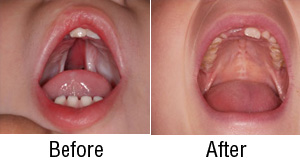| Treatment:
Repair of the palate is directed at producing normal speech, restoring eustachian tube function, attaining closure of oronasal fistulas and minimizing alterations in maxillary growth. Depending on the patient, repairs may start as early as 10 months or as late as 24 months.
Plastic Surgery:
 Planning for primary surgical repair begins in the hospital shortly after the child is born, or soon after discharge. A small or moderate degree of clefting may be repaired by simple closure; a larger defect may require a pharyngeal flap, alveolar arch alignment, orthodontic and dental work, and bone grafting. Dental, orthodontic or prosthodontic consultation is sought when teeth are malformed or missing. Bilateral clefts are the most complex to repair, requiring a spectrum of medical and surgical specialists. Planning for primary surgical repair begins in the hospital shortly after the child is born, or soon after discharge. A small or moderate degree of clefting may be repaired by simple closure; a larger defect may require a pharyngeal flap, alveolar arch alignment, orthodontic and dental work, and bone grafting. Dental, orthodontic or prosthodontic consultation is sought when teeth are malformed or missing. Bilateral clefts are the most complex to repair, requiring a spectrum of medical and surgical specialists.
In some cases, secondary soft palate (velopharyngeal) surgery may be necessary some months or years after primary palate repair, to correct hypernasal speech. Speech-language pathologists may assist in identifying the specific defect to be repaired. Velopharyngeal repair procedures include (1) palatal pushback plus pharyngeal flap lining, (2) posterior pharyngeal wall implant with Teflon injection, (3) pharyngeal flap, (4) palatopharyngeal flap, and (5) tissue expansion to create a flap.
Long-Term Treatment:
Some patients require months or years of speech-language training to acquire normal speech. The family members of a cleft palate patient may need long-term guidance and counseling to support them through the years of treatment. |

